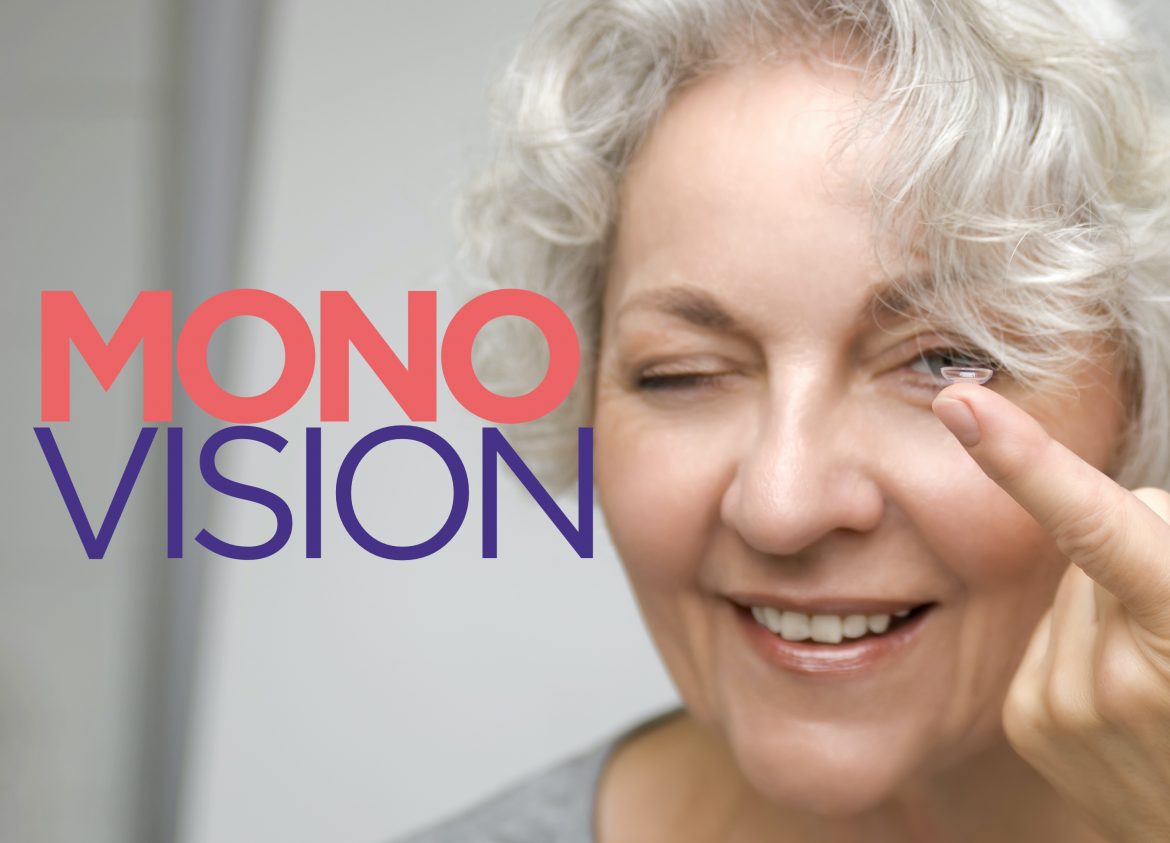![]()
Wearing your contact lenses and dealing with the onset of presbyopia can be frustrating. Wearing contacts is enough work, right? Do you really need to wear reading glasses too?
You probably know that presbyopia, the age-related loss of the ability to focus on nearby objects, is an unavoidable and natural part of the aging process that typically emerges in your 40s.
But did you know your presbyopia could be treated with monovision contact lenses? It has proven to be a very effective option for many “presbyopes.”
How monovision treatment works
Many of us have dealt with the effects of presbyopia the old-fashioned way—by wearing a cheap pair of magnified readers (a.k.a. “cheaters”). If you’re like me, you have a collection of them scattered around your house and in the car.
A less familiar, but potentially more effective option to deal with the effects of your aging eyes is a method of correcting your vision known as monovision—and specifically—monovision contact lenses.
Monovision contact lenses work by fitting each eye with a specific lens. One contact lens is for distance and another lens is for seeing and focusing on objects up close.
Most of us have a dominant eye and a non-dominant eye (if you are not sure which eye is dominant, it’s the one you prefer to use when looking at something with one eye closed). With monovision contact lenses, you wear a lens on your non-dominant eye to correct near vision and, if needed, a lens on your dominant eye to correct distance issues.
Also known as blended vision lenses, monovision contact lenses work by “tricking” your brain into recognizing the contact lenses as part of your natural vision. This forces your eyes to work together to see better both near and far. Interestingly, while this technique works well with contact lenses, using the monovision process with eyeglasses has been proven to be ineffective.
While monovision contacts may sound counterintuitive, most people find their eyes respond very well, improving their overall vision in the process. In fact, while it takes a week or so for the eyes to adjust to wearing two different strength contact lenses, research from The Physiological Society demonstrates that people using monovision contacts report amazing improvements in their overall vision. Most can’t tell which eye is adjusting for distance and which is being used for up-close objects.
Monovision lenses options
Your lifestyle or work may dictate how (and if) your eye doctor treats your presbyopia with monovision contact lenses.
For example, if you work at a computer for long periods of time, you’re likely to benefit from a lens prescribed to correct your vision for the intermediate distance of a computer screen.
If you spend a large portion of the day driving or participating in activities that require clear distance vision, your eye doctor may prescribe a lower than normal magnification for the near vision lens.
After using them, some people realize that monovision lenses just don’t work well for their specific needs. In these cases, a variation might include a bifocal contact lens in one or both eyes to correct vision.
Pros and cons of the monovision approach
Pros of monovision contacts
- Monovision correction can be achieved with almost any contact lens on the market. Your eye doctor will be able to offer a variety of contact lens options for materials, sizes, and shapes to suit your needs.
- As compared to wearing reading glasses with your contacts, your near vision is likely to be clearer with monovision contacts.
- Your adjustment period is likely to be quick.
- You’ll wear single vision contact lenses, which are less expensive than multifocal contacts.
Cons of monovision contacts
- You may notice slightly decreased distance or driving vision, especially at night. You may also experience increased glare at night.
- Your depth perception may be slightly decreased.
- If your prescription needs get stronger with age, it can become more difficult to rely on the monovision approach.
- You may be charged more for your monovision contact lenses fitting as it is more complex than a regular contact lens fitting.
Is monovision surgery a better option?
When it comes to monovision, the best way to determine if it’s a good fit for you is to talk to your optometrist and consider giving it a test run.
Should you find that monovision lenses correct your vision, you might consider a more permanent solution, like monovision surgery or monovision LASIK. Monovision LASIK produces the same corrected blended vision experienced with wearing the monovision lenses and eliminates the need to wear the lenses. Specifically, during a monovision surgical procedure, your dominant eye will be corrected for distance while your nondominant will be corrected for your near vision.
Like traditional LASIK surgery, the monovision LASIK procedure uses a laser to reshape the cornea to correct the refractive issues specific to your eyes. Since LASIK is a permanent procedure, it’s wise to consult with your optometrist and give monovision contact lenses a try prior to committing to the surgery.


